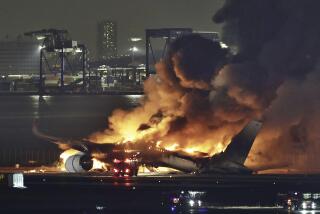The Chance to Live and to Tell About It : Air safety: Smoke hoods could help passengers survive a fiery crash, experts say. So why are federal officials resisting?
- Share via
A fiery collision on an airport runway. An airliner, its fuselage ruptured by the impact, is engulfed by flames. Inside, terror-stricken passengers who survived the crash shove their way toward exits. But many are overcome by smoke and the human crush. Their bodies will be found later in the wreckage.
If that scenario sounds like an account of the Feb. 1 crash at Los Angeles International Airport, it’s probably because the event is so raw in our memories. In fact, five years ago the Federal Aviation Administration produced statistics showing that between 1974 and 1984, an average of 30 people a year who survived an initial airliner crash in the United States died asphyxiation afterward. If international statistics were available, the figure would no doubt be several times higher. Fifty-five passengers lost their lives in a crash of a Boeing 737 at Manchester airport in England in August, 1985. At the inquest, Wing Cmdr. Ian Hill, a senior Royal Air Force pathologist, asserted that the crash “ought to have been wholly survivable.”
What many authorities believe would make such crashes “survivable” are smoke hoods containing either oxygen canisters to provide several minutes of breathable air or chemical pads to filter out smoke and toxic gases. The British Department of Transport’s crash investigator Edward Trimble describes them as “the solution which will give evacuating passengers the best chance of escape.” The Ralph Nader-affiliated Aviation Consumer Action Project has asked the FAA to require smoke hoods. Last year, the FAA did so--but only for flight crews, not passengers.
The FAA apparently agrees with airline-industry executives who contend that smoke hoods (officially called “protective breathing equipment”) are too complex to don easily and might delay evacuation. Industry officials also maintain that the hoods might not be able to cope with the level of toxic fumes inside a burning aircraft. Yet slowing down emergency evacuation might in itself save the lives of those who might otherwise be trampled during a panic. And other experts say that smoke hoods are generally less complicated to put on than standard-issue life vests. British crash investigator Trimble states flatly: “We have demonstrated the worth of smoke hoods by scientific data. There are really no arguments against them.”
Yet incidents of smoke-related airliner fatalities continue to mount:
--August, 1988. All 13 victims survived a Delta crash at the Dallas-Ft. Worth airport but died of smoke inhalation trying to escape. The Assn. of Flight Attendants said that smoke hoods “might have been helpful as emergency equipment.”
--December, 1990. Seven of the eight victims of a Northwest DC-9 crash at Detroit’s airport succumbed to smoke inhalation. C. William Kauffman, a professor of Aerospace Engineering at the University of Michigan, said later that smoke hoods could have prevented some fatalities. “The cabin fire at Detroit Metro should have been a survivable accident,” he declared.
--Feb. 1, 1991. Of the 34 victims of the USAir-SkyWest crash at LAX, 22 died of asphyxiation. Many of the USAir victims were found six rows from an emergency storage case containing smoke hoods for the crew. The case had not been opened, presumably because it was in what a National Transportation Safety Board spokesman describes as “an inconvenient location.”
In the wake of the LAX tragedy, there are new demands to upgrade traffic-control equipment at airports and make cabin interiors safer in the event of a crash. But clearly the fireproof jetliner is a long way off. In the meantime, smoke hoods would seem to provide the best assurance that passengers who have survived an airline accident will live to tell about it.
More to Read
Inside the business of entertainment
The Wide Shot brings you news, analysis and insights on everything from streaming wars to production — and what it all means for the future.
You may occasionally receive promotional content from the Los Angeles Times.










